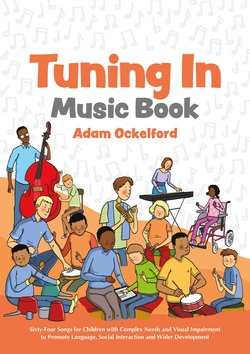Читать книгу Tuning In Music Book - Adam Ockelford - Страница 4
ОглавлениеHow will children engage with the songs?
Children and young people will engage with the songs in different ways, depending on their level of musical development, which can be ascertained using the Sounds of Intent framework. This identifies six potential stages in the development of musical understanding, and three domains of engagement: reactive (listening and responding), proactive (creating or re-creating sounds and music) and interactive (playing or singing with others). The six levels and three domains give 18 ‘headlines’ of musical engagement, which can be represented as shown in the diagram opposite.
At Sounds of Intent Level 1, children and young people will show no response to the songs (or, indeed, any sounds at all). However, that does not mean parents, therapists, teachers and carers should not try to engage them: it may be that a person’s ability to process sound and music is still developing, or is recovering after trauma, and musical exposure and interaction may be an important feature of either of those journeys. It may also be the case that responses are occurring on a neurological level that are not apparent through clinical or functional observation.
Children and young people functioning at Sounds of Intent Level 2 will experience the songs in a purely sensory way, and may join in by vocalising or making other sounds in response to what they hear. It is important to acknowledge whatever the children contribute, and to offer praise and show enthusiasm for their efforts. Be careful not to interrupt what they are doing, however. Allow plenty of time for them to process what they have heard, and remember that silence and stillness are as valid a response as any other, which may indicate concentration and enjoyment.
Children and young people at Level 3 will be able to catch on to the simple, moment-to-moment rhythmic and melodic patterns that characterise many of the songs, and they may well try to emulate these themselves. Again, give young people time to respond. And don’t be afraid of repetition, repetition, repetition: what you find tedious may be just what is required to spark a young brain into action. It is at this stage of musical development that a child may first grasp that sounds can be used symbolically – to stand for something else: an idea, a person, a place or an activity.
At Level 4, children and young people will start to learn, recognise and perhaps reproduce the main motifs from the songs: the short phrases that kick off many of the melodies, to which key words are set, and which are repeated often. In response, children may combine motifs in new ways to form ‘pot pourri’ songs, made up of fragments of familiar material. The motifs can also be used symbolically in their own right – with or without their accompanying words – to facilitate understanding and open up a channel of expressive communication, when language alone may not do the trick. This is generally the highest level of musical accomplishment that those with profound and multiple difficulties attain, and the strategies detailed on the Tuning In Cards do not move beyond this.
Level 5 is about complete songs being learnt, recognised and reproduced, at which stage children and young people may be able to join in by singing and perhaps playing melody or harmony instruments as well. It is important to remember that those with moderate or severe learning difficulties may be able to function musically as well as – or, in some cases, even better than – their ‘neurotypical’ peers.
At Level 6 children and young people will be able to perform the songs persuasively for others – perhaps leading music sessions not only for friends, but for strangers too, in unfamiliar contexts; able to adapt their performance and modes of musical interaction to suit different audiences.
The Sounds of Intent framework of musical development
